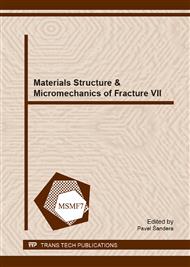p.96
p.100
p.107
p.113
p.117
p.121
p.125
p.129
p.133
Numerical Life Estimation of Structure Components Subjected to Hydrogen Embrittlement and Cycling
Abstract:
Engineering models to estimate a life of structure components which are simultaneously subjected to aggressive hydrogen environment influence and cycling, substantially, use two different approaches to problem-solving, i.e. the influence of aggressive hydrogen environment on material and the fatigue. A developed engineering model to estimate the life of structure components assumes that either the influence of aggressive hydrogen environment, or the fatigue initiates a local fracture of structure component. The engineering model enables a calculating of a structure component life.
Info:
Periodical:
Pages:
117-120
Citation:
Online since:
November 2013
Keywords:
Price:
Сopyright:
© 2014 Trans Tech Publications Ltd. All Rights Reserved
Share:
Citation:


